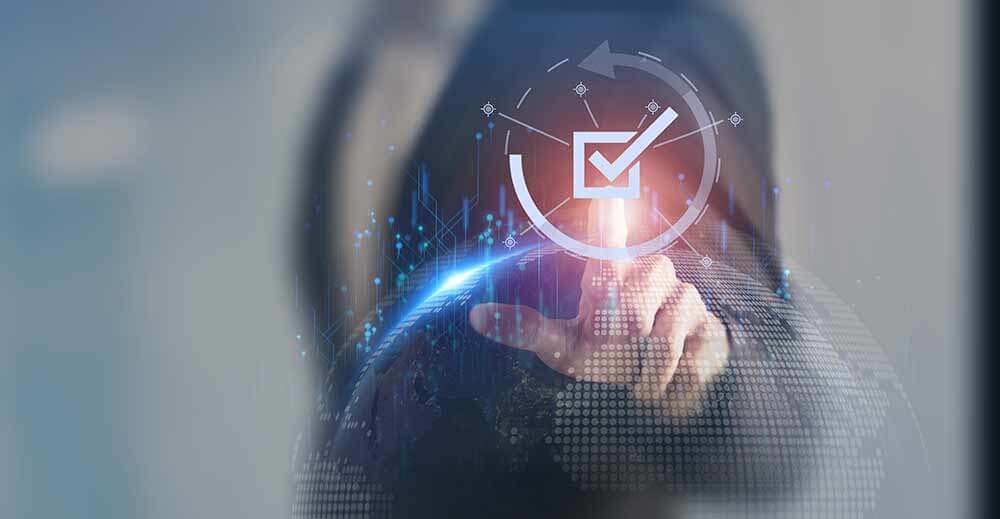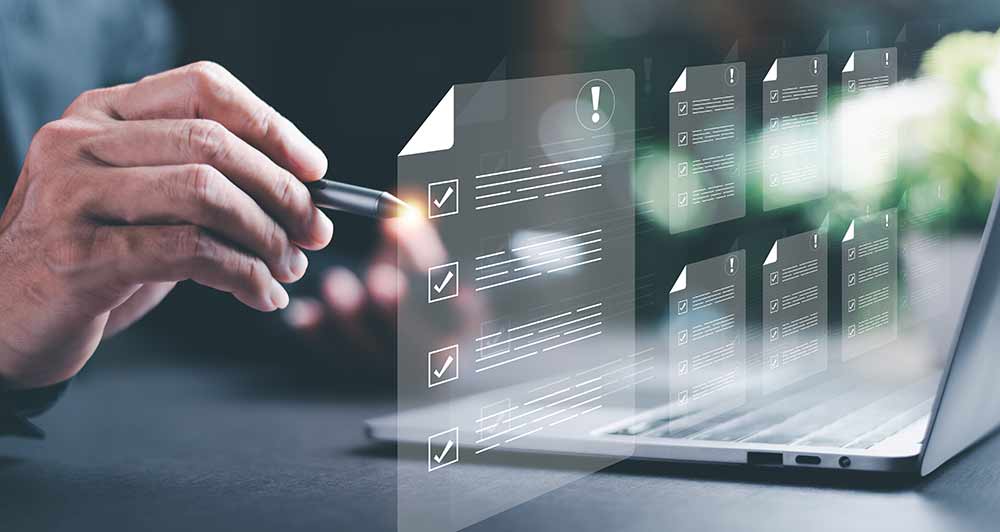Cybersecurity management is essential in today’s threat landscape. Whether an organization fills these responsibilities in-house, or works with a cyber security managed services provider, you need leadership (plus a team of experts) keeping your company secure.
But what goes into cybersecurity management? How do you cover all your bases?
Here’s everything you need to know.
What is cybersecurity management?
Cybersecurity management is the practice of defending an organization’s data, systems, and users from cyberattacks. It includes managing things like cybersecurity policies, assets, performance, and crisis response, in addition to employee training, data governance, and risk management.
While cybersecurity management was once treated as an IT responsibility, it has evolved into a separate (but related) discipline. Cyberthreats are evolving so fast that career IT professionals typically don’t have the bandwidth to stay on top of them. This creates a need for specialists managing cybersecurity—either in-house resources, our an outsourced partner.
Just how big is this burden?
Let’s take a look at the details. Here are 10 essentials that a good cybersecurity management practice should cover.
1. Strategic cybersecurity vision (with a 3-year roadmap)
Say you need to upgrade all network equipment in the next two years. Does the plan reflect input from career experts in cybersecurity?
Maybe you’re transitioning from an on-premises ERP system to a cloud system later this year. Have you gotten signoff—or revisions to the plan—from career experts in cybersecurity?
Long-term strategic vision is one of the hardest things to get right in cybersecurity management. It takes a leader with significant expertise and experience to define your needs in cybersecurity and how you’ll get there.
(Hint: This is one benefit of working with a full-service MSSP who provides executive-level consulting in cybersecurity. You get the power of a CISO, or chief information security officer, without the high salary.)

2. Regulatory compliance
Do you know what cybersecurity regulation applies to your organization? Depending on your industry and location, there may be laws at the local, state, and federal level that require compliance. Common gap assessment frameworks include:
- DFARS (for US Department of Defense contractors)
- NIST (numerous industries)
- HIPAA (healthcare industry)
- PCI/DSS (for any company that handles credit card data)
- CJIS (for organizations that access criminal justice information)
Regulatory compliance is one of the most challenging aspects of cybersecurity management. It’s one thing to conduct a gap assessment yourself (or work with a trusted advisor to do so). It’s far more challenging to close any identified gaps using in-house resources. This is why many organizations outsource this portion of cybersecurity management.
3. Disaster preparedness
Is your organization ready for a devastating cyberattack?
If criminals hack an essential system and hold it for ransom, have you analyzed the impact to customers, internal users, finances, legal standing, and reputation?
Do you have a plan in place to respond?
If you’re like most organizations, you either need to update that plan—or start creating it.
This is an essential component in cybersecurity management, yet it often gets pushed to the back burner. It’s a challenging task that requires input from every part of the organization. This is why many companies engage a trusted advisor to help develop this plan. An advisor brings a wide perspective from working with clients in numerous industries. They’re also up to date on the latest cyberthreats, giving them unique insight that you can’t get from internal resources.

4. Policy management
From data governance to email access protocols, cybersecurity management has wide-ranging implications for internal processes. It’s essential to define these policies, communicate them clearly with all stakeholders, and keep them up to date.
Like disaster preparedness, cybersecurity policy management can easily fall by the wayside when things get busy. This is why many organizations engage a trusted partner to help them develop, communicate, and maintain these essential policies. It’s yet another way to make sure you leave no stone unturned.
5. Risk management
Unfortunately, there’s no way to eliminate cybersecurity risk. A 100% bulletproof organization wouldn’t be able to conduct business.
But more importantly, it isn’t possible to achieve 100% assured security. Threats are always evolving, operating systems are always being updated, and new employees can arrive on the scene without adequate security training.
Luckily, cybersecurity risk management isn’t about eliminating all risks. Rather, the goal is to define and quantify risks, define acceptable levels of risk, and mitigate risks to those acceptable levels.
The process starts with a cybersecurity risk assessment—one of the bedrocks of cybersecurity management. While you could theoretically do it yourself, this assessment is typically performed by a trusted advisor, since it’s an audit of your internal systems, policies, and configurations.

6. Physical security
Cybersecurity management doesn’t stop with digital systems. Physical access to devices, networks, and data is the very first layer of defense.
What does this look like?
Depending on your budget and requirements, you may benefit from:
- Fences surrounding your facilities
- Barred windows
- Keycard or biometric access controls
- CCTV cameras
- Motion sensors and alarms
Not every company needs every control, but physical security is a critical component in cybersecurity management.
7. Asset management
Every physical device can pose a cybersecurity threat—from PCs to servers to network firewalls and more. Cybersecurity management must account for them.
Digital assets, like an essential database or a critical cloud system, also fall under the domain of cybersecurity management.
It’s essential to keep a real-time inventory of all assets, both physical and digital, that require cybersecurity controls. If this list of assets and their statuses isn’t up to date, you have unidentified risk on your hands.
8. Performance management
How effective is your overall cybersecurity investment—both in financial terms, and in terms of attacks prevented?
These are essential questions to define how your cybersecurity program is performing. Yet answering these questions presents two specific difficulties:
- Getting accurate performance data
- Communicating the right data effectively to other stakeholders
Luckily, you can overcome each of these challenges—you just need the right tools and expert resources.
Getting accurate performance data
There are two facets to cybersecurity performance data. You’ll want to cover each one.
- Cyberattacks prevented (and other KPIs). You can get this information from a SIEM solution—although you’ll need to know which KPIs matters most. SIEM solutions provide a ton of information, which is why most organizations outsource this function to a managed SIEM provider.
- Cybersecurity ROI (or ROSI). The C-suite will want to know what “return” you’re getting on your cybersecurity investment. However, cybersecurity isn’t a revenue driver, so the traditional ROI calculation really doesn’t apply. Rather, you’ll want to calculate ROSI—return on security investment. Check out our FREE Cybersecurity ROSI Calculator for more information.
Communicating the right data effectively to other stakeholders
A good process for cybersecurity performance management will produce an overwhelming amount of data. The challenge, after filtering that data, is to craft clear communication for other stakeholders within the organization.
This is another area where many organizations lack the internal resources to do this effectively. It takes significant professional experience to take the most important KPIs and communicate them without jargon. This is why many companies rely on a cyber security managed services provider to understand and communicate the value that security measures provide.

9. Crisis management
Effective crisis management doesn’t start with a cybersecurity incident. It starts long before, with appropriate risk analysis, controls, protocols, cybersecurity experts, and response processes in place.
In fact, one could argue that everything in this article is necessary to prepare an organization for effective crisis management. But at a high level, here’s what it takes.
- People. You can’t manage a cybersecurity crisis without the right people in place. You need specific cybersecurity experts like network security analysts, penetration testing specialists, intrusion detection analysts, and—of course—a CISO (chief information security officer). Hint: It’s incredibly difficult to hire and retain top cybersecurity experts in-house. This is why many organizations outsource their cyber needs. Even the CISO role can be outsourced with a vCISO (virtual CISO) consultant who serves on a fractional basis. Here at Corsica, every client gets a vCISO who works with them intensively to assist with the strategy, execution, and management of cybersecurity.
- Processes. You can’t manage a cybersecurity crisis if you haven’t defined all processes related to cybersecurity—both your day-to-day processes, and your crisis response protocols. These policies are complex and require an experienced strategic vision. This is why many organizations outsource to an MSSP.
- Technology. You can’t stop technological threats without the right technology. Solutions like SIEM and MDR are essential to cybersecurity management—and they’re just the beginning. Whatever technology you use to manage cybersecurity, you’ll need experts monitoring your software and responding to incidents. This is a tall order, and it’s one of the primary reasons companies outsource their cybersecurity management.
10. Essential services in cybersecurity management
So far, we’ve covered cybersecurity management at the 50,000-foot level.
But what does effective management look like on the front lines of cyber warfare?
Here’s what it takes to manage cybersecurity from top to bottom. Some organizations can cover all of these services in-house, while others may outsource some (or all) to an MSSP (managed security services provider).
General Security Services
- Managed Detection and Response (MDR). If you can’t detect a cyberattack, you can’t respond to it—let alone stop it in real time. MDR combines endpoint detection software (which spots malicious activity on devices connected to a network) with managed services for triage, containment, remediation, and consulting to prevent similar incidents. MDR is essential to managing cybersecurity effectively.
- Security Information and Event Management (SIEM—pronounced “sim”). This software solution aggregates as much cybersecurity information as possible in a single user interface. It also gives administrators the tools they need to respond to security incidents in real time. Since a SIEM solution requires round-the-clock human monitoring, most organizations outsource this essential function of cybersecurity management.
- Security Alerting and Containment. Not every MSSP actually remediates incidents. Some only provide notifications to the client, letting them know something’s on fire. This may be helpful if you have your own staff managing cybersecurity. However, most organizations don’t have these resources, so they outsource this function to a trusted partner—a full-service MSSP who does remediate incidents.
- Dark Web Monitoring. Here’s a hard truth: Your organization’s information may be for sale on the dark web. But how would you know until criminals purchase your stolen credentials and breach your network? Dark web monitoring can detect this threat before it becomes active. Clearly, this type of monitoring is an essential component in cybersecurity management.
- Phish Testing and Security Awareness Training. Unfortunately, phishing emails are proliferating like never before. Do your employees know how to spot one? Or are they easy picking for criminals? Does your company provide phishing training? Psychological manipulation and manufactured urgency make phishing emails quite compelling. Training your employees to recognize these threats is a key component in cybersecurity management.
- Blocking Phish Emails. Microsoft 365 and Google Workspace aren’t perfect when it comes to cybersecurity. Next-generation threats like targeted spear phishing, social engineering, rogueware, scams, bank fraud and data exploitation can still sneak past the defenses that are built into Microsoft 365 and Google Workspace. Strong cybersecurity management requires a strategy for stopping phishing emails from even reaching inboxes.
- Browser Protection. The most devious browser attacks can trick even a well-educated employee. An additional layer of browser protection blocks against social engineering scams, credential stealing, shareware, rogue software, and communication callbacks.
- Managed Patching. Every system needs patches from time to time. These updates help mitigate newly-discovered vulnerabilities—yet most organizations struggle to keep up with patching. Whether you outsource this function or cover it in-house, it’s an essential part of cybersecurity management.
Network Security Services
- Managed Network Devices. Network devices like firewalls, switches, and wireless access points all fall under managed network services. Even cloud networks should be included in this portion of cybersecurity management. While some organizations have enough resources to manage network security in-house, others outsource to a managed network services provider.
- Preventative Maintenance. The moment you switch to “react” mode, you introduce risk into your cybersecurity management practices. It’s essential to perform maintenance before it’s needed. This way, you help prevent incidents and outages that truly were preventable. Organizations that can’t handle this portion of cybersecurity management should consider an IT outsourcing company for this function to an MSSP.
- Threat Hunting. Do you know what threats are lurking on your network? If you don’t engage in threat hunting, you’ll never know until it’s too late. This essential cybersecurity management practice helps uncover threats before criminals turn them into active attacks.
Server Security Services
- Managed Servers. Like everything else IT-related, servers fall under cybersecurity management. Yet most organizations lack the resources to handle server security in-house. These companies typically outsource this function to an MSSP, who keeps servers updated with the latest operating systems and patches.
- Backup and Disaster Recovery Services. Also known as DRaaS (disaster recovery as a service), this solution makes copies of critical data and saves them for speedy restoration. It’s an essential part of cybersecurity management, and whether you do it in-house or outsource it, make sure you (or your trusted advisor) can develop a business continuity plan to complement your backup protocols.
- Microsoft 365 and Active Directory Administration. Are your directories configured for maximum security? Do you regularly delete unused accounts? Have you locked down the ones you still need? Directory security is an essential component of cybersecurity management.
End User Security Services
- Managed Workstations. When it comes to employee computers, preventative maintenance is the key. Cybersecurity management requires keeping every operating system and all hardware up to date and secure.
- Workstation Repair/Reimage. While preventative maintenance is essential, there’s no silver bullet that can prevent all workstations from experiencing security incidents. If a device has been hacked, it will need to be repaired or reimaged. This may ultimately land on IT’s desk, but cybersecurity management requires understanding what happened on the device—and preventing it in the future.
These specific services are the foundation of cybersecurity management. They work together to bring leadership decisions to the front lines of cyber warfare. Whether you manage these aspects of cybersecurity in-house or outsource them, you’ll want to make sure you cover them all.
Moving forward: Managing cybersecurity effectively
As you can see, cybersecurity management is a significant undertaking. From the 50,000ft level to analysts handling threats, it takes dedicated professional resources.
Global enterprises can typically afford their own cyber teams. For the rest of us, it’s a tall order to hire and retain an entire team of experts. This is why so many companies outsource to an MSSP (managed security service provider). That’s what we’re all about here at Corsica Technologies. From penetration testing to risk assessments, SIEM to MDR, we handle cybersecurity from top to bottom.

Need help managing cybersecurity?
Reach out to schedule a consultation with our security specialists.






